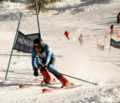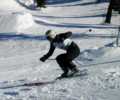|
Story
by Randy H. Milgrom
Audio by Bob Merion and Peter
Ottlakan
Photography by Bob Garypie and
Peter Ottlakan
To
the Top
Nendaz snuggles right up to the base of the mountainous peak
where this week’s slalom events take place. To reach the downhill
race venues, village dwellers are treated to a vigorous walk
up a gently rising slope to the tram station, where they are
whisked up the mountainside in a roomy, glass-enclosed cable
car. It’s a slow ride along a gentle rise – an improbably
casual lift that floats higher and higher above the stunning
landscape of the Bernese and Vaud Alps. Though on some days
it may begin its rise from a foggy Nendaz into an uncertain
mist, the cable car unfailingly bursts through the haze and
into a blindingly blue sky at the top.
Two
at a Time
This morning’s parallel slalom is the
culminating event – it’s not only the last alpine race of
the week, but it also brings all participants together in
one final competition. Age categories, strictly adhered to
all week long, are ignored for this last free-for-all, and
all willing skiers are pitted against one another – two by
two – for one last quick wiggle down the slope.
Two runs – one outfitted with blue gates and the other with
red – are placed side by side, in surprisingly close proximity,
and two skiers are directed to simultaneously propel themselves
toward the bottom of the slope. Seedings for first round match-ups
are based on participants’ recorded times for yesterday’s
slalom event, which was also held on the course being used
for today’s parallel slalom. Victorious skiers advance in
a “lose and you’re out” format.
Two skiers ski calmly along a ridge and into the starting
blocks. Almost immediately, they’re off at the sound of a
piercing electronic bell – popping up out of a crouch and
down the steep incline with a stabbing thrust of their poles.
It’s a short course – eight gates in all – and it’s very
quick. The more accomplished racers treat the gates as a mere
annoyance, if not with disdain. These impressive athletes
proceed down the hill as if the markers weren’t there at all
– barely glancing in their direction, brushing past them without
a thought. Though a slightly exaggerated bend of the knees
can occasionally be detected, that is all that seems to be
required to send a skier around one bend and down toward the
next.
Beat Gottschalck, kidney recipient and technical director
of the Games, lasted into the final round of eight, but he
took his ouster in stride. “If they hadn’t divided the age
groups, I might have had a chance,” he joked. “But I’m too
old.”
An
Upcoming Duo
Great Britain’s Mark Brown competed in each of the alpine
events this week, and he started strong before losing in his
final pairing of the morning by a slim .28 seconds. Despite
the heartbreaking loss, Mark seemed oddly serene and willing
to talk about it just minutes following his ouster.
Mark was born nearly 34 years ago with Alport’s Syndrome,
a hereditary disease, so he knew since he was a child that,
“my kidneys were slowly deteriorating.” At the age of 27,
he began dialysis treatments, and after 20 months he received
a transplanted kidney. This May, he’s taking a year off to
travel around the world with his girlfriend, Joanne Green.
(“I know,” he agreed, “we make a colorful couple.”)
“I couldn’t do it before my transplant, so I may as well
do it now,” he says – not so much to the person he’s talking
to, or even to himself, but rather, it seems, to just anybody
who wants to know it.
Or maybe he’s talking to his younger brother, James, who
is not here at these Games, but who has inherited the same
disease. James started dialysis in August and is waiting for
a donor kidney. Mark hopes to bring his brother to the next
Transplant Games as a participant.
They’ll make a wonderful pair.
|














